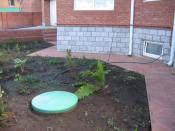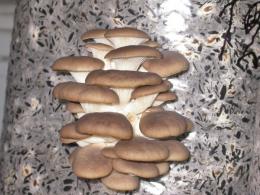Search
Login
Growing oyster mushrooms in the garden
Mushrooms - a valuable food product, in its chemical composition - this is a real storehouse of useful elements. Dried mushrooms contain up to 30% protein and this is more than in many vegetables and meat.
The composition of the mushroom protein includes most of the essential amino acids that ensure the normal functioning of the human body. A person needs only 100 grams of dried mushrooms per day to maintain protein balance. Mushrooms are used in the treatment of even cancer, due to the high content of sulfur compounds.
Content
- Mushroom Breeding History video
- Oyster mushroom characterization
- Methods for growing oyster mushrooms
- Growing oyster mushrooms from mycelium grown in natural conditions
Mushroom Breeding History
Most edible mushrooms began to be cultivated artificially more than 2000 years ago in the countries of Southeast Asia.
Shiitake is considered to be the oldest artificially grown mushroom. It was started to grow on wood in Japan, then in Korea, China and on the island of Taiwan.
Then they began to artificially grow winter mushrooms, in the 50s of the 20th century a method for cultivating winter mushrooms on woodworking waste was patented in Japan.
Now, the industrial production of winter honey is conducted in the countries of the Far East, Holland and takes third place in the world after champignon and oyster mushroom.
In Europe, interest in the artificial cultivation of edible mushrooms appeared much later.
At the beginning of the 19th century, mushrooms were cultivated in Russia.
Initially, champignons were grown in dugouts for sale, gradually more and more people began to understand the benefits and by the end of the 19th century, more than a hundred amateur mushroom growers appeared in Russia.
The most famous mushroom, grown not only in industrial conditions, but also in summer cottages, in basements and even apartments - is oyster mushroom.
It was first grown in Germany in the late 19th, early 20th century. In modern times, oyster mushroom culture has spread widely in Europe, Asia and America.
Oyster mushroom characterization
In nature, oyster mushroom, grows on dead wood of various hardwoods (poplar, aspen, birch, etc.). Its large fruiting bodies, throughout the summer and autumn, appear in large splices up to 30 specimens.
The cap of this mushroom has a convex or funnel-shaped bluish-gray, dark-gray or grayish-brown color, with light plates that run down to the leg. The leg is often lateral, sometimes central, sometimes completely absent.
The pulp is white, with a pleasant specific smell. Since oyster mushroom develops only on dead wood, so do not be afraid that it can infect living trees in your garden.
Methods for growing oyster mushrooms
There are many ways to grow oyster mushrooms both indoors and outdoors.
Usually, mycelium (mycelium) is sold in specialized stores, ready-made on grain, sawdust, in straw, etc.
But you can grow oyster mushroom with the help of spores and mycelium collected in natural conditions.
For growing oyster mushrooms on a personal plot, use stumps left from old felled fruit trees (apple trees, pears, etc.). You can use just logs cut from softwood, but the diameter of the logs should be at least 150 mm. and contain enough moisture.
In practice, it has been established that the thicker the stump, the larger will be the caps of the mushrooms grown on it. The general rule for selecting a wood substrate has been revealed; it consists in the fact that the thicker the tree, the better. Because on thick stumps, the crop appears a little later, but more abundant fruiting and much longer in time.
Disputes can be obtained from freshly picked or purchased at the store quality and ripe oyster mushrooms.
Hats with plates, on which spores are located, are crushed, filled with water and shaken well.
Several holes are drilled on the surface of the stumps, with a diameter of up to 3 cm, a depth of 5 cm, or make cuts with a saw.
In these holes, the resulting aqueous suspension of spores is poured.
Then, to protect the wood from drying out, it is covered with moss, bark, straw and deepened into the ground.
Growing oyster mushrooms from mycelium grown in natural conditions
The best results are obtained when stumps are infected with pieces of wood with oyster mushroom mycelium found in natural conditions.
Having found such a mycelium in the forest, it is necessary to cut out from the zone of active growth of the mycelium, i.e. from sites where the greatest growth of mushrooms is observed.
Pieces of grafting wood are laid in the holes previously drilled in the stumps, you can attach nails to the end surface of the stump.
Further, the wood is also covered with wet sawdust, moss or twigs. After 2-3 months, the mycelium grows and permeates all the wood.
In the dry season, infected stumps are periodically moistened.
Oyster mushroom grown in the above way can bear fruit from 3 to 7 years.
In order to achieve a good, constant crop, it is necessary by this method to infect stumps throughout the growing season.
Great success can be achieved by working in spring or autumn.
Gradually, each amateur mushroom grower accumulates his own experience, which in the future allows him to achieve certain success.





